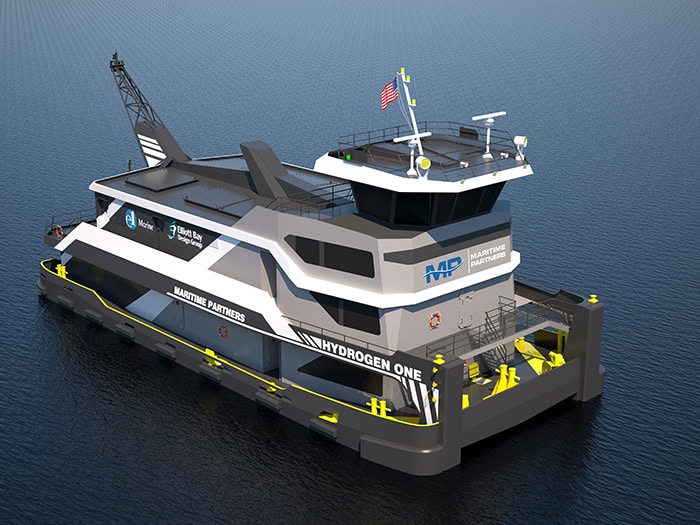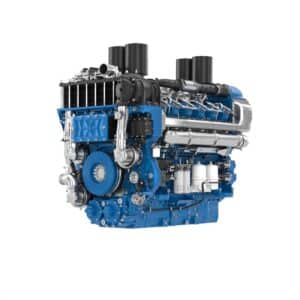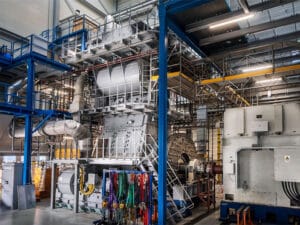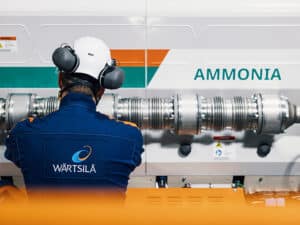
The developing rules of alternative fuels
Written by
The M/V Hydrogen One. (Credit: Maritime Partners)
By Juliette Lehman, naval architect, Elliott Bay Design Group
Editor’s Note: This article appeared in the March 2024 issue of Marine Log magazine.
Presently, the maritime industry is faced with revolutionary change as it aims to decarbonize its global fleet. As of 2023, the International Maritime Organization (IMO) has set revised decarbonization targets to promote the implementation of zero and near-zero greenhouse gas (GHG) emission fuels and energy sources, reduce carbon intensity, and reach net-zero GHG emissions by 2050 for international shipping. To meet these ambitious targets, the maritime industry has turned to alternative fuels, such as ammonia, methanol, hydrogen, and battery electrification, as one such decarbonization solution.
Faced with uncharted waters, classification societies are working to develop a set of alternative marine fuel rules, not only with enormous speed, but also with appropriate consideration for the safety of crew, vessel, and environment. In the United States, designs must also adhere to the U.S. Coast Guard’s regulations, making Coast Guard approval of rule sets a key element in rule development. Although daunting, the creation of these rule sets helps to usher in the newest era of maritime technology, in which designers, rule-writers, and operators can work in partnership to create solutions that are safe, sustainable, and feasible.
The International Association of Classification Societies (IACS) is an organization that provides technical support to its member societies, aiding in rule development and research. In 2022, IACS consisted of eleven member societies: American Bureau of Shipping (ABS), Bureau Veritas (BV), China Classification Society (CCS), Croatian Register of Shipping (CRS), Det Norske Veritas (DNV), Indian Register of Shipping (IRS), Korean Register of Shipping (KR), Lloyd’s Register (LR), Nippon Kaiji Kyokai (NK), Polish Register of Shipping (PRS), and Registro Italiano Navale (RINA), accounting for 90% of global tonnage classed that year. With IACS comprising most of the classed global shipping, a review of its member societies can provide insights into the trends in rule setting for the maritime industry.
Each IACS member society develops their own rule sets for their classed vessels. However, IACS can publish Unified Requirements (URs), setting minimums for member societies to implement into their individual rule sets.
As of January 2024, IACS has released a UR for “Control of Ammonia Releases on Ammonia Fuelled Vessels,” outlining safety measures that are to be included in the design of ammonia-fueled ships. While this is the first UR related to alternative fuels to be released, IACS stated that URs for hydrogen-fueled vessels and electrical energy storage systems are currently under development. Additionally, IACS has stated its support for IMO’s carbon intensity targets and developed the Safe Decarbonization Panel (SDP), which is comprised of a representative from each of the member societies. The panel has stated that ammonia, hydrogen, carbon capture and storage (CCS), and batteries are of top priority. To date, the individual IACS member societies have also started to develop rule sets and guidelines on ammonia, methanol, hydrogen, and batteries as vessel fuels.
Class society rule sets are ever evolving, incorporating findings from experience in design and operation. Class society rules have often seen points of significant overhaul in the wake of maritime disasters, such as the Exxon Valdez oil spill and subsequent requirement for double bottom hulls, in which rule sets become more stringent with time. However, the rules currently under development for alternative fuels are looking to take a more proactive approach to addressing potential risks. The sensitivity to the protection of human life and the environment has increased through time, prompting class societies to take additional care in developing such revolutionary rules.
When a new technology is on the horizon, class societies have the difficult task of developing rule sets to meet the rapidly forming demands of the industry. The maritime industry has certainly experienced technological revolution before – the transition from sail to steam, and again from steam to diesel, which caused rule sets to develop rapidly. Although the rapid need for rule sets to meet changing technology is not entirely unprecedented, the shift to alternative fuels is arguably much more varied. With liquids, such as methanol, ammonia, and hydrogen, as well as battery electrification, looking to be implemented, classification societies are developing rules on multiple fronts.
But how does a class society go about creating rule sets for untested technologies? First, the fuels themselves are not truly novel – class societies are able to pull from expertise developed from carrying alternative fuels as cargo, LNG-fueled vessels, and land-based operations. Ammonia, methanol, and hydrogen have been carried as cargo on ships for many years, with much safety and design experience gained. Class societies can pull from this existing experience, identifying gaps between safety measures required for carrying these liquids as cargo and utilizing them as vessel fuels.
Additionally, IMO’s “IGF Code,” which provides design standards for vessels fueled by gases or low-flashpoint fuels, can act as a foundation for alternative fuel rules. Each of the alternative fuels being focused on presents its unique challenges, differing in flash points, toxicity levels, and environmental impact. Rules for each fuel must be adapted to appropriately address their varying risks. To do so, risk-based analysis is employed by class societies to identify additional risks associated with using these gases as ship-based fuels.
Because these gap analyses are performed based on rule sets and experience with larger vessels, there is a challenge present in applying these technologies to smaller vessels under these rules. Arrangements that work well on a larger vessel may dominate spaces of a smaller vessel. Additionally, arrangements and technology required may be prohibitively expensive for smaller owners and operators.
While it may seem that this method of rule development limits the ability to apply them to smaller vessels, there is an important process occurring that helps to expand the applicability of these rules. As these rules are being developed, engineers, operators, and class societies can partner to refine them. These partnerships typically involve design projects to understand how written rules translate into vessel design. Partnerships between operators, engineers, and class societies create opportunities for all parties to increase their knowledge and expertise with these emerging technologies.
Elliott Bay Design Group (EBDG) has partnered with operators and class societies on several projects to develop design solutions for these emerging technologies and gain insight into the development of these rules. EBDG’s patent pending Clean Harbor Alternative Mobile Power (CHAMP) Barge concept provides a cost-effective clean charging solution for harbor vessels and a flexible alternative to conventional shore power for ships both at pier and anchor. This concept design has been discussed with ports and operators interested in being at the forefront of the alternative fuel transition.
The Hydrogen One, designed by EBDG for Maritime Partners, is the world’s first methanol-fueled tugboat and is IMO-2030 compliant. Hydrogen One serves as an example of how creative solutions can be applied to small-vessel design to implement alternative fuel technology. In developing these concepts, EBDG engineers have engaged extensively with the United States Coast Guard to develop regulations relevant to this technology and have provided feedback and findings to class societies interested in refining alternative fuel rules.
The global maritime transition to alternative fuels provides a few challenges, especially as class societies work to develop rules that weigh timely implementation, safety of crew and vessel, and cost. Although formidable, these challenges create opportunity for industry partnership as the global fleet implements more sustainable technologies.




